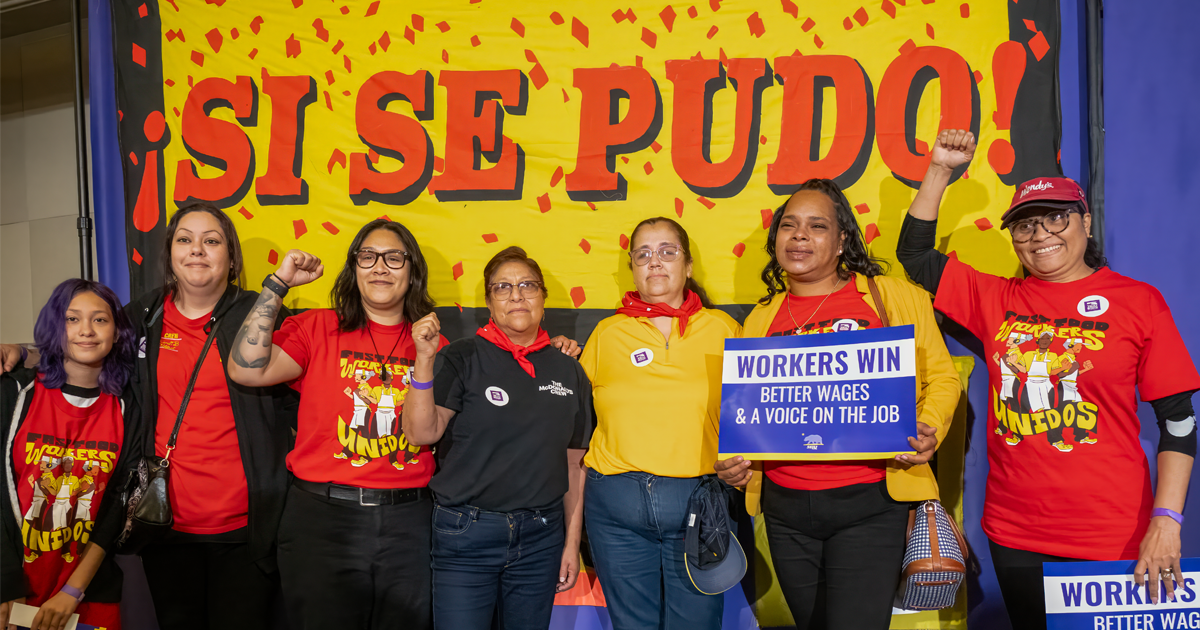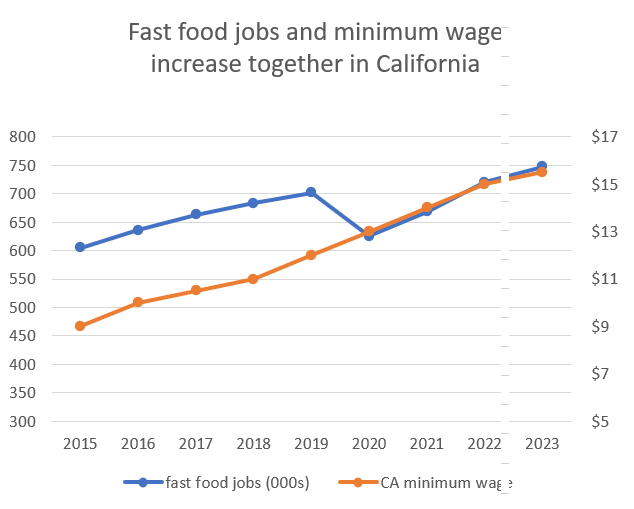Victories: $20 hour for California fast food workers

As of April 1st, California fast food workers must earn at least $20/hour. This is why $20 an hour is good for California’s fast food workers and employers. Work in the California fast food and and not making $20/hour? Send us a report!
Our research shows In the real world, fast food jobs increase or stay the same after big boosts in the minimum wage:
- From 2015 to 2023, California raised the minimum wage by 72 percent, from $9 an hour to $15.50 an hour.
- While the minimum wage was rising, fast food restaurants in California added 142,000 jobs.
- The minimum wage has increased every year in California since 2015. So has the number of fast food jobs in California, except for 2020, when the COVID pandemic hit.

- Numerous academic studies confirm: When states and cities pass big minimum wage increases, employers either add jobs or there is no or minimal effect on employment.
- A 2024 study of fast food employment as California and New York nearly doubled the minimum wage to $15 found no fast food job loss and, after the pandemic, actual increases in fast food employment.
- A 2018 study of six cities – three of them in California – found a 2.1 percent increase in restaurant and other food service jobs after large minimum wage increases.
- A 2019 study of 138 state minimum wage increases found “no evidence of disemployment when we consider higher levels of minimum wages.”
- A 2021 study of 21 city-level minimum wage increases found that “employment changes were negligible.”
- One reason: Higher pay means fast food workers quit less often, reducing turnover and vacancies or “increasing the number of filled jobs.” Lower turnover also raises productivity and lowers costs for recruitment and training.
- A 2021 study found that state and local minimum wage hikes around the U.S. had no effect on McDonald’s opening or closing restaurants.
Raising the wage for fast food workers is a matter of racial and gender justice.
With over half a million workers, 80 percent of them workers of color, 60 percent Latina or Latino, and two-thirds women, the fast food industry must be a vital component of any effort to address inequity through empowerment.
New report by the nonpartisan Legislative Analyst’s Office is full of good reasons for raising fast food workers’ pay to $20:
- Raising pay for fast food workers is essential since they are the second-largest group of low-wage workers in California. Fast food cooks and counter workers are the state’s second largest low-wage occupation, behind home care aides. Elected leaders have recognized the need to raise pay for both groups of low-wage workers. The state raised fast food workers’ pay to $20 an hour starting April 1, 2024. A separate bill raises home health aides and other health care workers pay over time, ultimately reaching $25 an hour.
- Increasing California’s minimum wage to $16 has not been enough to shrink the wage gap between low-wage workers and average workers in California. That’s because over the last decade pay for the typical (median-earning) California worker has risen just as fast as wages for low-wage earners (those in the bottom 10 percent of earners – such as fast-food workers).
- The wage gap persists for low-wage Latina/Latino workers as well, even after Increasing California’s minimum wage to $16. The gap between the lowest-paid Latina/Latino workers and the lowest-paid white workers is 20 percent – about the same as it was 20 years ago. Fast food workers in California are 60 percent Latina/Latino.
- California is not an outlier in setting its minimum wage. The typical worker nationally (earning the median wage) earns about twice the minimum wage. So does the typical California worker. Comparing median wages and minimum wages, California “is comfortably within the range of minimum wage increases in the U.S. over the last four decades—closer to the bottom of that range than the top.”
- At the statewide $16 minimum wage, workers cannot afford housing in the state’s large population centers. Not alone; not with a minimum wage earning partner; and certainly not with children. And, for single parents making the $16 minimum wage, housing is “unaffordable throughout California,” not just in the major metro areas.
Robots aren’t replacing humans in fast food restaurants:
- McDonald’s CEO Chris Kempczinski says that at $20 an hour, humans are more cost-effective than robots: “[C]ould we do automated fryers? Could we do automated grills? … [M]ost of those are not ready for prime time nor will they be ready for prime time over the next 5 years or so. … the cost of that equipment were nowhere near to what the breakeven would need to be from a labor cost standpoint to make that a good business decision … [D]oes the business case pencil? In most cases right now, even if labor gets to $15, $20 an hour which in some parts of the world it is over $20 an hour, it still doesn’t pencil at that.”
- In other words, as Kempczinski said a year later: “you’re not going to see, like I said, robots in the restaurant.”
- When fast food chains add automation, they “aren’t really replacing people. The technology allows us to reallocate our human resources to value-added, customer-facing tasks that enhance the guest experience,” says the CEO of a regional fast food chain.
- Despite what actual fast food executives say, “experts” keep predicting robots will replace fast food employees – in the future:
- 2013: “there is a 92% chance that fast food preparation and serving will be automated in the coming decades.”
- 2020: “82 percent of restaurant positions could potentially be replaced by robots.”
- 2023: “Millions of fast food workers could lose their jobs within 5 years.”
There’s a restaurant labor shortage – higher pay helps: A fast food industry publication said the $20 wage could help restaurants “recruit more staff and boost morale.”
- That would address some of the industry’s biggest problems. According to the National Restaurant Association:
- 88% of restaurant operators say they want to hire employees this year – “if they can find qualified applicants.”
- 45% of restaurant operators say they “need more employees to support customer demand.”
- And more than one in four say their most significant challenge is “recruiting & retaining employees.”
Fast food corporations don’t need to raise prices more – they have already raised prices a lot:
- Fast food prices have risen almost 15 percent in the last two years, according to the Bureau of Labor Statistics.
- Some companies have raised prices even more:
- McDonald’s has raised prices more than 20 percent in the last two years: a 10 percent increase in 2023 on top of a 10 percent increase in 2022.
- Chipotle has raised prices four times in the last two years, totaling well over 20 percent, including a mid- to high-single-digit price increase announced in October, a 5.6 percent price hike earlier this year, and an earlier “mid high single digit” price increase in August 2022 and a 4 percent hike in the first quarter of 2022.
“Greedflation” has fattened profits.
Profits at the nine large publicly traded fast food chains have roared back since the pandemic. That list includes McDonald’s, Starbucks, YUM! Brands (parent of KFC, Taco Bell and Pizza Hut), Restaurant Brands International (Burger King, Popeye’s and others), Wendy’s, Chipotle, Jack in the Box, Domino’s Pizza and Papa John’s Pizza.
- Eight of the nine corporations posted double-digit operating profit increases from 2019 to 2023. (Restaurant Brands International operating income rose by 5 percent in the period.)
- Price increases are a key reason for the higher profits, as the companies themselves report:
- McDonald’s: “Comparable sales results benefited from strong average check growth driven by strategic menu price increases.”
- Jack in the Box “restaurant-level margin expanded year-over-year by 450 basis points from 16.2% up to 20.7%, driven by menu price increases as well as a change in the mix of restaurants.”
- Starbucks: “Our US company operated business delivered 5% comparable store sales growth in Q1, driven by 4% ticket growing from pricing, mix, and customization.,“
Roosevelt Institute research establishes that implementation of the $20 per hour fast-food minimum wage in California will not necessitate price hikes or employment losses because profits in the industry are sufficiently high to absorb the greater operating costs.
- Between 2014 and 2023, fast-food prices increased by 46.8% compared to 28.7% for the average of all prices.
- In 2023 alone, the ten largest publicly traded fast-food companies spent $6.1 billion on share repurchases.To cover the cost of increased wages, fast-food companies could merely reduce– not even zero-out– their returns to shareholders.
- In 2023, the ten largest publicly traded fast-food companies made $20.9 billion in profits, suggesting considerable room on their balance sheets to cover wage increases.
- In 2023 alone, the average markup in the fast-food industry jumped by 8.4% while markups for firms across all industries grew by 6.2%.
- In 2023, fast-food firms charged prices that were 27% above firms’ production costs.
Pizza Hut planned move to third party delivery over a year before wages went to $20: Press reports have often tied the recent layoff of 1,200 Pizza Hut drivers, to the new $20/hour fast food minimum wage, which took effect April 1. However, as Los Angeles Times reported, Pizza Hut began outsourcing deliveries to Uber Eats and other delivery services in 2022. Pizza Hut made that move because they couldn’t find enough drivers. In fact, the Wall Street Journal reported that because of the driver shortage Pizza Hut and other chains might “expand perks and benefits, including time off and in some cases the use of company-owned cars.”
Franchisees are often large businesses: Fast food franchise owners often portray themselves as small business people. But many franchise owners are wealthy, large operators:
- In fast food, 82 percent of franchise owners are multi-unit operators And the average multi-unit franchise owner has five locations.
- Just to open one fast-food restaurant requires on average an initial investment of between over $700,000 and over $2 million.
When franchisees face financial challenges, franchisors, whose profits have been increasing, can and should lighten their demands on franchisees. They already do this often, when it serves their interests.
- Burger King is subsidizing store modernization.
- McDonald’s has lowered new franchisee investment requirement to help potential operators from “underrepresented groups” join the system.
- During the pandemic, numerous fast food corporations, from giants like Subway and Taco Bell parent YUM! Brands, to smaller franchisors such as Barberitos lowered or deferred royalties and fees.
